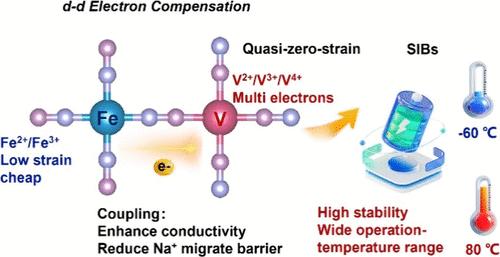Rational Design of Prussian Blue Analogues for Ultralong and Wide-Temperature-Range Sodium-Ion Batteries
IF 15.6
1区 化学
Q1 CHEMISTRY, MULTIDISCIPLINARY
引用次数: 0
Abstract
Architecting Prussian blue analogue (PBA) cathodes with optimized synergistic bimetallic reaction centers is a paradigmatic strategy for devising high-energy sodium-ion batteries (SIBs); however, these cathodes usually suffer from fast capacity fading and sluggish reaction kinetics. To alleviate the above problems, herein, a series of early transition metal (ETM)–late transition metal (LTM)-based PBA (Fe-VO, Fe-TiO, Fe-ZrO, Co-VO, and Fe-Co-VO) cathode materials have been conveniently fabricated via an “acid-assisted synthesis” strategy. As a paradigm, the FeVO-PBA (FV) delivers a superb rate capability (148.9 and 56.1 mAh/g under 0.5 and 100 C, respectively), remarkable cycling stability over 30,000 cycles, high energy density (259.7 Wh/kg for the full cell), and a wide operation-temperature range (−60–80 °C). In situ/ex situ techniques and density functional theory calculations reveal the quasi-zero-strain and multielectron redox mechanisms of the FeVO-PBA cathode during cycling, supporting its higher specific capacity and stable cycling. It is considered that the d–d electron compensation effect between Fe and V enhanced the reversibility and kinetics of redox reactions and simultaneously improved the electronic conductivity and structural stability of the FeVO-PBA cathode. This work may pave a new way for the rational design of high-performance cathode materials with bimetallic reaction centers for SIBs.

超长宽温程钠离子电池普鲁士蓝类似物的合理设计
设计具有优化协同双金属反应中心的普鲁士蓝类似物(PBA)阴极是设计高能钠离子电池(sib)的典范策略;然而,这些阴极通常存在容量衰减快和反应动力学缓慢的问题。为了解决上述问题,本文采用“酸辅助合成”的方法制备了一系列早期过渡金属(ETM) -晚期过渡金属(LTM)基PBA (Fe-VO、Fe-TiO、Fe-ZrO、Co-VO和Fe-Co-VO)正极材料。作为范例,FeVO-PBA (FV)提供了极好的倍率能力(分别在0.5和100℃下为148.9和56.1 mAh/g),在30,000次循环中具有卓越的循环稳定性,高能量密度(全电池为259.7 Wh/kg)和宽工作温度范围(- 60-80°C)。原位/非原位技术和密度泛函理论计算揭示了FeVO-PBA阴极在循环过程中的准零应变和多电子氧化还原机制,支持其较高的比容量和稳定的循环。认为Fe和V之间的d-d电子补偿效应增强了氧化还原反应的可逆性和动力学,同时提高了FeVO-PBA阴极的电子导电性和结构稳定性。本研究为合理设计具有双金属反应中心的高性能sib正极材料开辟了新的道路。
本文章由计算机程序翻译,如有差异,请以英文原文为准。
求助全文
约1分钟内获得全文
求助全文
来源期刊
CiteScore
24.40
自引率
6.00%
发文量
2398
审稿时长
1.6 months
期刊介绍:
The flagship journal of the American Chemical Society, known as the Journal of the American Chemical Society (JACS), has been a prestigious publication since its establishment in 1879. It holds a preeminent position in the field of chemistry and related interdisciplinary sciences. JACS is committed to disseminating cutting-edge research papers, covering a wide range of topics, and encompasses approximately 19,000 pages of Articles, Communications, and Perspectives annually. With a weekly publication frequency, JACS plays a vital role in advancing the field of chemistry by providing essential research.

 求助内容:
求助内容: 应助结果提醒方式:
应助结果提醒方式:


